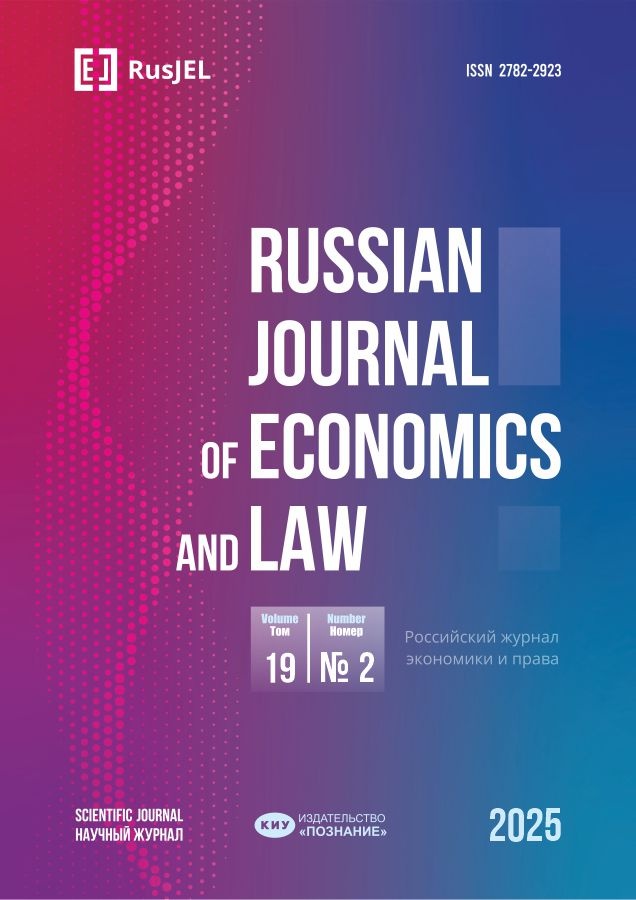Toward national regulation of legal technology: a path forward for access to justice
- Авторлар: Simshaw D.1
-
Мекемелер:
- Gonzaga University School of Law
- Шығарылым: Том 19, № 2 (2025)
- Беттер: 345-389
- Бөлім: TRANSLATED ARTICLES
- URL: https://bakhtiniada.ru/2782-2923/article/view/305094
- ID: 305094
Дәйексөз келтіру
Толық мәтін
Аннотация
Негізгі сөздер
Әдебиет тізімі
- Alteneder, K., & Rexer, L. (2014). Consumer Centric Design: The Key to 100% Access. Journal of the Law Society, 16(5), 13.
- Asay, C. D. (2020). Artificial Stupidity. William & Mary Law Review, 61, 1193.
- Baxter, R. (2022). Dereliction of Duty: State-Bar Inaction in Response to America's Access-to-Justice Crisis. Yale Law Journal Forum, 132, 228.
- Brescia, R. H., McCarthy, W. A., McDonald, A. M., Potts, K. B., & Rivais, C. (2015). Embracing Disruption: How Technological Change in the Delivery of Legal Services Can Improve Access to Justice. Albany Law Review, 78, 553–554.
- Cabral, J. E., Chavan, A., Clarke, T. M., Greacen, J., Hough, B. R., Rexer, L., Ribadeneyra, J., & Zorza, R. (2012). Using Technology to Enhance Access to Justice. Harvard Journal of Law & Technology, 26, 257.
- Cruz, S. E. (2019). Coding for Cultural Competency: Expanding Access to Justice with Technology. Tennessee Law Review, 86, 364.
- Cyphert, A. B. (2021). A Human Being Wrote This Law Review Article: GPT-3 and the Practice of Law. UC Davis Law Review, 55, 404.
- Fortney, S. S. (2019). Online Legal Document Providers and the Public Interest: Using a Certification Approach to Balance Access to Justice and Public Protection. Oklahoma Law Review, 72, 94–95.
- Gordon, R. W. (2019). Lawyers, the Legal Profession & Access to Justice in the United States: A Brief History. Daedalus, 148(177), 177–178.
- Greely, H. T. (2020). The Law of the Tetrapods. Vanderbilt Journal of Entertainment and Technology Law, 22, 266.
- Green, B. A. (2023). Why State Courts Should Authorize Nonlawyers to Practice Law. Fordham Law Review, 91, 1274.
- Guttenberg, J. A. (2012). Practicing Law in the Twenty-First Century in a Twentieth (Nineteenth) Century Straightjacket: Something Has to Give. Michigan State Law Review, 2012, 415–491.
- Hadfield, G. K., & Rhode, D. L. (2016). How to Regulate Legal Services to Promote Access, Innovation, and the Quality of Lawyering. Hastings Law Journal, 67, 1195.
- Himonas, D. G., & Hubbard, T. J. (2020). Democratizing the rule of law. Stanford Journal of Civil Rights & Civil Liberties, 16(2), 261–263.
- Jewel, L. A. (2017). The Indie Lawyer of the Future: How New Technology, Cultural Trends, and Market Forces Can Transform the Solo Practice of Law. SMU Science and Technology Law Review, 17, 340.
- Johnson, L. D. (2020). Navigating Technology Competence in Transactional Practice. Villanova Law Review, 65, 163.
- Kluttz, D. N., & Mulligan, D. K. (2019). Automated Decision Support Technologies and the Legal Profession. Berkeley Technology Law Journal, 34, 874. https://doi.org/10.2139/ssrn.3443063
- Knake Jefferson, R. N. (2012). Democratizing the Delivery of Legal Services. Ohio State Law Journal, 73(6), 44–45.
- Kunkel, R. (2019). Rationing Justice in the 21st Century: Technocracy and Technology in the Access to Justice Movement. University of Maryland Law Journal of Race, Religion, Gender and Class, 18, 382–383.
- McCauley, J. (2016). The Future of the Practice of Law: Can Alternative Business Structures for the Legal Profession Improve Access to Legal Services? University of Richmond Law Review, 51, 55, 59.
- McPeak, A. (2019). Disruptive Technology and the Ethical Lawyer. University of Toledo Law Review, 50, 466.
- Medianik, K. (2018). Artificially Intelligent Lawyers: Updating the Model Rules of Professional Conduct in Accordance with the New Technological Era. Cardozo Law Review, 39, 1515.
- Moore, T. R. (2019). The Upgraded Lawyer: Modern Technology and Its Impact on the Legal Profession. UDC/DCSL Law Review, 21, 27.
- Pasquale, F., & Cashwell, G. (2015). Four Futures of Legal Automation. UCLA Law Review Discourse, 63, 34.
- Perlman, A. M. (2015). Towards the Law of Legal Services. Cardozo Law Review, 37, 82–83.
- Poppe, E. S. T. (2019). The Future Is Bright Complicated: AI, Apps & Access to Justice. Oklahoma Law Review, 72, 188.
- Rhode, D. L., & Ricca, L. B. (2014). Protecting the Profession or the Public? Rethinking Unauthorized-Practice Enforcement. Fordham Law Review, 82, 2588.
- Sandefur, R. L. (2020). Legal Advice from Nonlawyers: Consumer Demand, Provider Quality, and Public Harms. Stanford Journal of Civil Rights and Civil Liberties, 16, 312.
- Sandefur, R. L., & Denne, E. (2022). Access to Justice and Legal Services Regulatory Reform. Annual Review of Law and Social Science, 18, 38.
- Schmitz, A. J. (2020). Measuring "Access to Justice" in the Rush to Digitize. Fordham Law Review, 88, 2393.
- Sharkey, C. M., & Fodouop, K. M. K. (2022). AI and the Regulatory Paradigm Shift at the FDA. Duke Law Journal Online, 72, 107–108.
- Simshaw, D. (2022). Access to AI Justice: Avoiding an Inequitable Two-Tiered System of Legal Services. Yale Journal of Law and Technology, 24, 150.
- Simshaw, D. (2023). Toward National Regulation of Legal Technology: a Path Forward for Access to Justice. Fordham Law Review, 92(1), 1.
- Staudt, R. W. (2009). All the Wild Possibilities: Technology That Attacks Barriers to Access to Justice. Loyola of Los Angeles Law Review, 42, 1122.
- Tepper, R. L. (2020). The Flexible Lawyer: Promoting Agility and Innovation. Arizona Attorney, 57, 28.
- Terry, L. S., Mark, S., & Gordon, T. (2012). Trends and Challenges in Lawyer Regulation: The Impact of Globalization and Technology. Fordham Law Review, 80, 2663.
- Wald, E. (2022). The Access and Justice Imperatives of the Rules of Professional Conduct. Georgetown Journal of Legal Ethics, 35, 421.
- Walters, E. (2019). The Model Rules of Autonomous Conduct: Ethical Responsibilities of Lawyers and Artificial Intelligence. Georgia State University Law Review, 35, 1076.
- Yu, P. K. (2020). The Algorithmic Divide and Equality in the Age of Artificial Intelligence. Florida Law Review, 72, 344.
Қосымша файлдар








